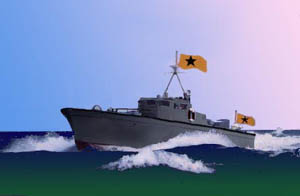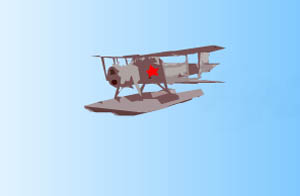Sacco and Vanzetti Special Craft
Seaborne

|
|---|
| An RSEE shows its seaworthiness |
Each fleet is also equipped with its own attachment of a relatively new design of fishing craft. Primarily designed for Rescue, Search, Emergency and Exploration (known as RSEEs) the vessels are based on the Commonwealth's vast experience at sea. The RSEE's special features mean that it is highly manoeuvrable, very fast and has a low profile in the water.
The vessels operate in "clouds" of 15 craft, with an additional five on rest and refuelling rota for each fleet. Working together, specially-designed balloons (which are deployable both in air and water) they can, if necessary, replicate the radar and sonar return signals of a variety of ships, from submarines to aircraft carriers. However, their low profile, high speed and use of angle hull and superstructure make the RSEEs extremely difficult to detect electronically.
Seaborne members of Project Mayhem operate their own fleet of RSEEs, known as "Cloud 9".
It is believed these new fishing vessels operate in international waters, refuelling at various locations and through The Movement's super-freighters S&VSS Serendipity and S&VSS Que Sera, although Serendipity has been loaned to Peripheral Boundary and its current location is unknown.
Each RSEE is equipped with chaff and flare dispensers, radar and sonar detection and reflection equipment, smoke dispensers and two fishing rods.
Their displacement is 175 tons and top speed is 32 knots with a crew of four and a maximum passenger capacity of six.
Airborne

|
|---|
| A RMR MkI on a routine mission |
The most common aircraft in use in Sacco & Vanzetti is the RuMouR Mk I, more than 300 are in service.
Its chief operational uses are Rescue, Meteorology and Reconnaissance, for which it is ideally suited. Made entirely of wood and plastics, it does not cloud radar with its footprint, its slow airspeed and great manoeuvrability means it can fly low, avoiding unsightliness, it has a huge range and very short takeoff and landing capabilities.
The standard crew of two leaves room for two additional passengers, if required, although most commonly, the extra seats are occupied by children enjoying the thrill of aerial patrols.
It carries no armament but is equipped with very advanced fish spotting and sounding radar with a full spherical sweep of land, sea and air. Radar projection equipment allows combinations of the craft in certain formations to replicate the footprints of either fast-moving jet planes or slower-moving craft carrying large payloads. Standard rescue equipment includes two forward-firing, 50 mm, shark cannons.
Later advances in design and equipment specifications have seen the production of Mk II, Mk III and Mk IV versions although not in the same numbers. However, the Buenaventura Durruti Jungle Academy of Streetfighting maintains and operates a complement of 87 of the very latest models.
